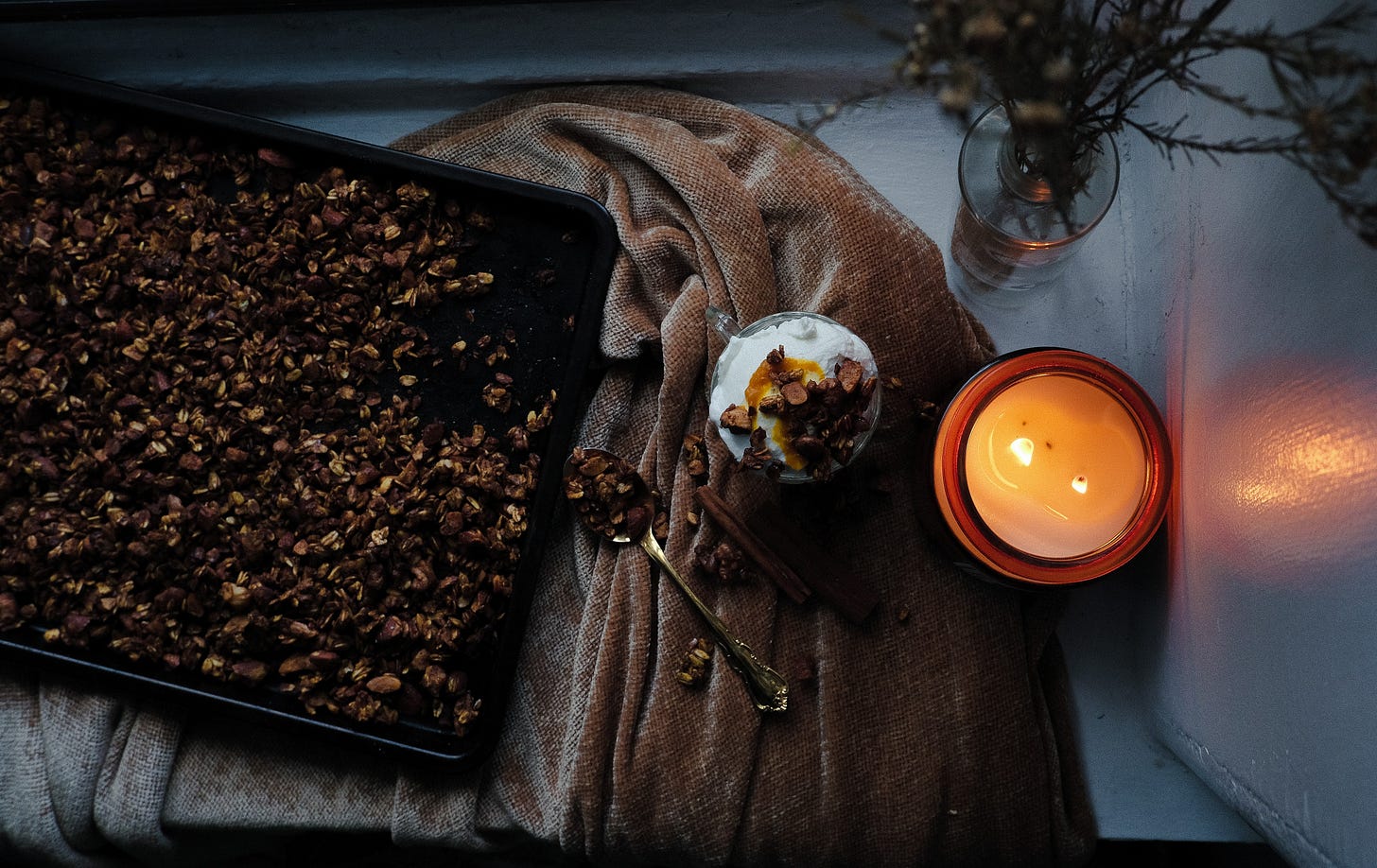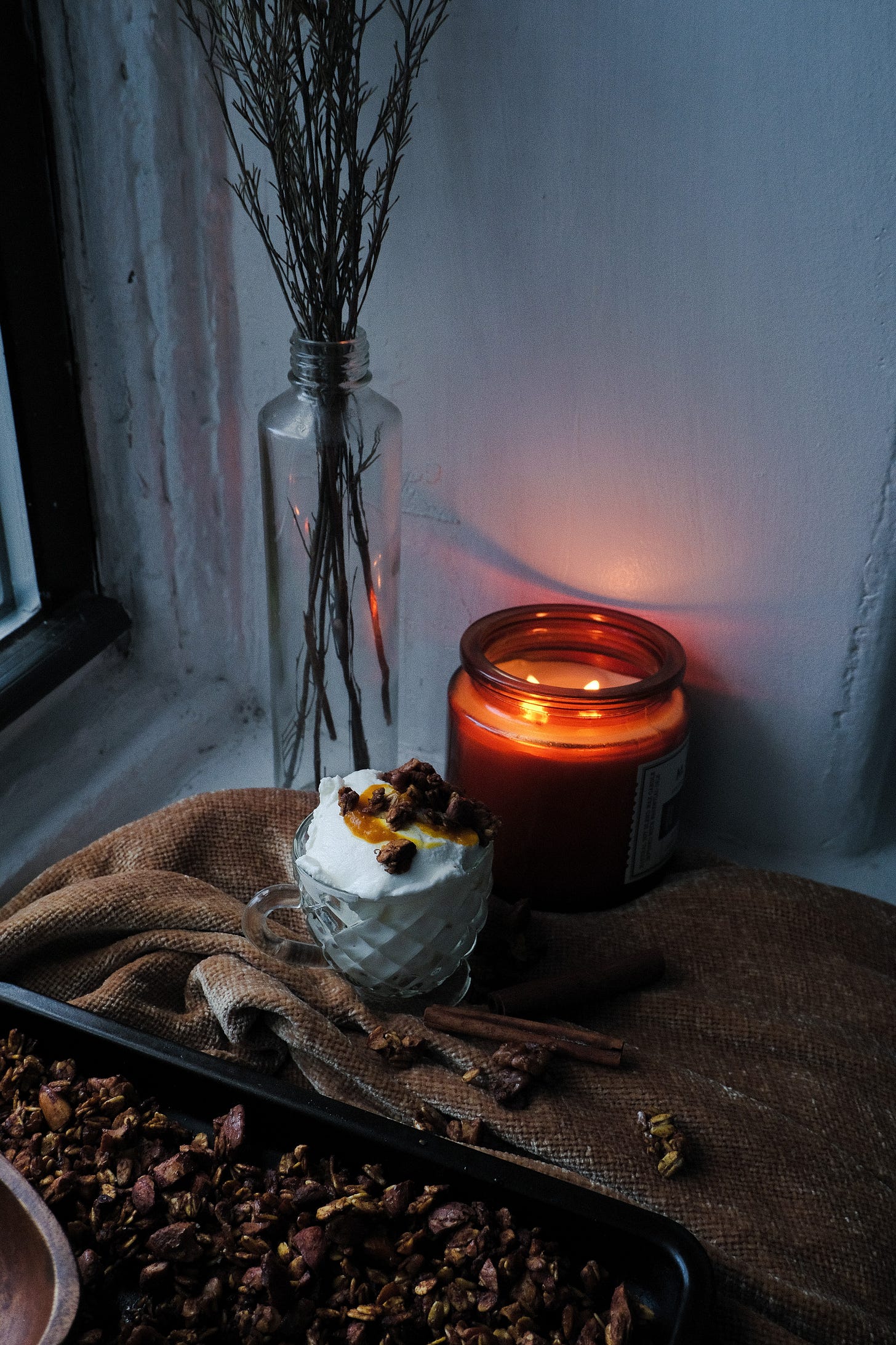Dipping Mahamri In Chai With Patricia Anyango - No. 4
And that first slice into…someone else's wedding cake.
If the stars have magically aligned and placed you here, reading my newsletter, but you somehow have not subscribed, don’t get your panties in a bunch (or whatever you’re wearing or not wearing…this is virtual, so no judgment) — subscribe! Here! Now! And receive a fun story, dip recipe, and hilarious puns every Friday directly to your inbox.
Welcome back to Vegarie, where I’m super excited to be joined by Patricia (Trish) Anyango: home-baker, speech-language pathologist, and overall creative. She’s humble about it, but you’ll catch her posting many fantastic meals and how-to cooking tips on her Instagram stories (@trishaanyango) that leave us all absolutely drooling. Together, we talk about the Indian influences present in Kenyan cooking, her qualms with the meat and produce quality here in the US, and I learn something I didn’t know about my friend—why she connects so deeply with baking. On top of that, Trish also leaves me with an assignment; to make Mahamri, an East African beignet-esk doughnut, and chai tea. Although I didn’t receive a fully passing grade on my first attempt—I was given more of a “T” as in, “weelll, you tried—” it will just have to pass for dip this week. But trust me, regardless of my stumble, mahamri are simple, tasty, and more than worth a week sans-dip. As a bonus, I dug up my old recipe for chai-spiced honey in honor of our conversation that will make you want to cozy up with a blanket next to the fireplace—or possibly a fall-scented candle.
First, Trish and I met at Western Washington University during undergrad, where we both worked as campus event assistants. Both Geminis—born just 3 days apart—Trish and I being very similar, bubbly, and adorable, were neck and neck for the role and didn’t even know it. Hence, we split the position and then, of course, became best friends. Trish studied speech therapy and constantly blows me away with her patience and ability to intuitively counsel children, myself included. Because I count as a child…right? Born and raised in Nairobi, Kenya, Trish didn’t move to Kennewick, Washington until she was 9. Led to make their favorite meals from home, she and her mom, Grace, struggled to find proper spices, quality meats, and produce when they first arrived in the US. Forced to adapt to the major differences, Trish’s family made the best of whatever they could find in Kennewick.
“One of my favorite things is finding a great African or East African spice market. You get in there, and geek out—cause I suddenly see everything I grew up with and it's really nostalgic.”
Take ugali for example, which Trish says her family uses as a base for most of their dishes. Ugali is a corn meal combined with boiling water and formed into a ball by “kneading the LIFE out of it.” You then take pieces of ugali and create a little boat in your hands—aww!—add vegetables, eggs, or meat, and dip said boat into a soup before eating it. But the problem is that the corn meal in Kennewick is “the type to make cornbread with, and not ugali. It's ground more coarsely. [Whereas] the kind at home is fresh, like the type you'd get from a sack, straight from the farm, freshly ground. It wasn't until I moved to Dallas that I finally found cornmeal that properly tasted like ugali from home.” Similarly, her family adapted to lower meat and produce quality.
“The meat back home is extremely lean, like the animals stay outside. It's not pumped with hormones like it is here, it's out in the farm, much nearer. You'll see that they're a lot smaller. They're more gamey. And here, the meat is fatty. That was one of the main things I noticed when I first moved here, I was like, what the heck?! This isn't chicken. This is mushy.”
Outside of ugali, a favorite of Trish’s is homemade chapati, an Indian flatbread that her family eats with stewed mung beans, curry powder, and cumin that comes together to make a spicy, warm, and comforting dish. “There are a lot of Indians in Kenya, so we were heavily influenced by their cooking. And my mom used to have a best friend who's Indian and taught us to make chapatis.” According to Trish, chapatis are quite simple. Her mom takes some flour, water, oil, and a little sugar to form the dough. Once the dough forms, she rolls it out into circles, brushes it with oil or ghee, and pan-fries it.
When asked if the rest of her family cooks, Trish said “big time.” All three aunts and her grandma have a lot of talent in the kitchen. According to Trish, her aunt Nancy is the best.
“She is the one person who, when I go home, I always go straight to the kitchen and sit with her while she's cooking. She's passionate about it, and you can feel it in the flavors that the passion is there.”
Her other aunt, Janet, who passed away a few years ago, was the baker of the family. Janet would make birthday cakes every year. She would make cakes for special occasions or holidays and was even hired to bake wedding cakes. Known for her raisin spice cake that everyone requested, Janet “would make us an extra cake each time so we could have a taste. Thinking about those mornings is still really comforting for me.”
“One year the house smelled especially good when I woke up, and I didn't know [my aunt] had made the cake for someone's wedding. So—my ass—I go to the living room and grab a piece of cake. And I'm like, "haaaappy birthdayyy…" And she looks at me like, “are you actually serious right now?”
Janet just made another one. However, she did have to call the bride, letting her know that her niece took a chunk out of their wedding cake the morning-of. Don’t worry Trish, I’m sure she understood. A girl’s gotta eat.
In Kenya, women are the homemakers. “They are known as mothers, cooks, housewives, or whatever. So, as little girls, we were in the kitchen from a young age.” The cool thing about Trish’s family is that they always insisted she help out from very early on, holding her first knife and cutting tomatoes when she was only three years old. Impressive. When I was three, I think I just drew pictures of tomatoes with my box of supa-sharp crayons.
“I like to bake cake. I just really like cake, I can't help myself.”
Trish bakes, things like pound cake, zucchini bread, pumpkin loaves. Cinnamon rolls, cookies, items on the sweeter end. She even started working a bit with pastry at home, trying more savory puff pastries with gruyere and ham. Baking brings up memories of time spent with Janet, and the kitchen full of women growing up. It was remarkable to learn that’s why she continues to push herself as a baker.
Now, for my assignment: Mahamri. It's an East African doughnut, similar to a beignet, light and airy, but seasoned with cardamom. “We have something we call ‘tea time’ back home. If you’re feeling fancy, we would have mahamri with tea or coffee, maybe some honey or jam. Some people even eat them with curry, as a sweet-savory thing believe it or not.” For a proper tea time, I’ll need a special chai tea, not just your traditional Indian masala chai. I’m told to look for Kenyan black tea and the regionally recognized tea brand “Ketepa,” if I can find it—spoiler: I do, and you can too at Kalustyan’s in Manhattan*. After adding in cinnamon sticks, cardamom pods, ginger root, and cloves, it makes a robust tea, spicy, and that's why you make it with milk.
** I want to note that I found this in person, and it looks like the site only carries their store-brand Kenyan black tea blend.
Along with the mahamri, Trish says her family regularly made something she called a “butter sandwich.” Yep, just like it sounds. Can we vote to make butter a food group? I’d support that…Take about 1/2 tbs margarine spread called blue band, spread on white bread, fold, and eat. Almost immediately after writing this, I went to work and cut myself on a butter knife…which sparked a profound thought. If you cut yourself on a butter knife, does that make you butter?
“Food brings a sense of being loved and I use it to express love.”
I like to end each interview on Vegarie with this simple question, why is food special to you? And why do you think food brings so many people together?
“Growing up, even when I was very little, food was a definition of family. Wherever we are, as long as we're spending time together, everything is centered around food. So for me, food has always brought this sense of belonging. It's brought a sense of being loved and I use it to express love. So that's really what food means to me. It's showing love and how much you care for people.”
Thank you again Patricia for taking time out of your busy week, melting my heart—and my butter—with your answers, and sharing laughs over stories with your aunts in the kitchen! I appreciate you more than you know.
Chai-Spiced Honey + Granola
Ingredients (Chai Honey):
1 cup honey
1/2 tsp cardamom (ground)
1 tsp cinnamon (ground)
1/4 tsp cloves (ground)
1/4 tsp ginger (ground)
Instructions:
Bring all ingredients into a small sauce pan over low heat. Stir consistently until it’s reached a slow simmer. Remove from heat and store in a air-tight container at room temp. Use for topping yogurt bowls, ice cream, or sweetening coffee. Also, you can use it in my granola recipe below for the ultimate warm and spicy hug.
Ingredients (granola):
Dry
1 1/2 cups rolled oats
1 cup walnuts, roughly chopped
1/2 cup almonds or cashews, roughly chopped
1/3 cup pepitas, whole
2 tbs hemp seeds
2 tbs chia seeds
2 tbs flax seed (ground)
1 tsp cinnamon (ground)
1/2 tsp cardamom (ground)
1/2 tsp ginger (ground)
1/2 tsp clove (ground)
1/2 tsp salt
Wet
2 tbs olive oil, or sunflower or avocado oil
1/4 cup chai spice honey
1 tsp vanilla extract (optional)
Instructions:
Preheat oven to 325F/165C.
Combine all dry ingredients in a large mixing bowl.
In a small sauce pan, over medium-low heat combine your chai spiced honey and oil and bring to a bubble. Once the honey and oil come to a boil, remove from heat and your vanilla extract. Pour wet ingredients into dry and toss evenly.
Spread mixture onto a baking sheet, toast for 15 min in the oven, toss & toast for another 15 minutes. Keep doing this until golden brown and your house smells like heaven, often times this takes about an hour.
On the last removal, let the granola cool completely before tossing or attempting to remove it from the baking sheet as this will help to create larger clumps of granola—the best part, if I do say so myself. Once completely cool, remove from sheet and transfer to an air-tight container. This will store well for up to 2-3 weeks on your shelf, but is best texture and brightest flavor when consumed within the first week. So share with your friends over African chai tea and mahamri!
Bring people together and make them smile.






